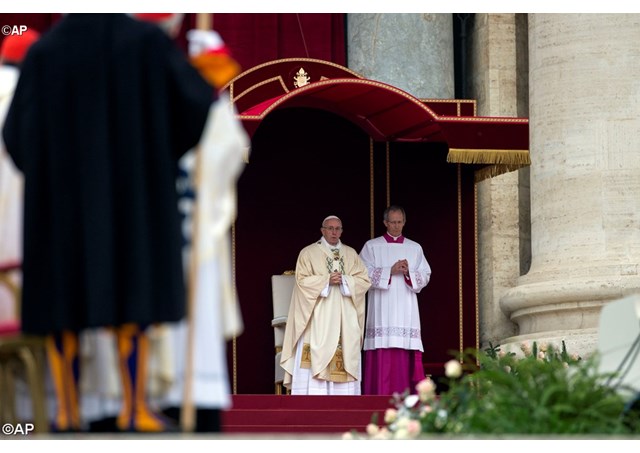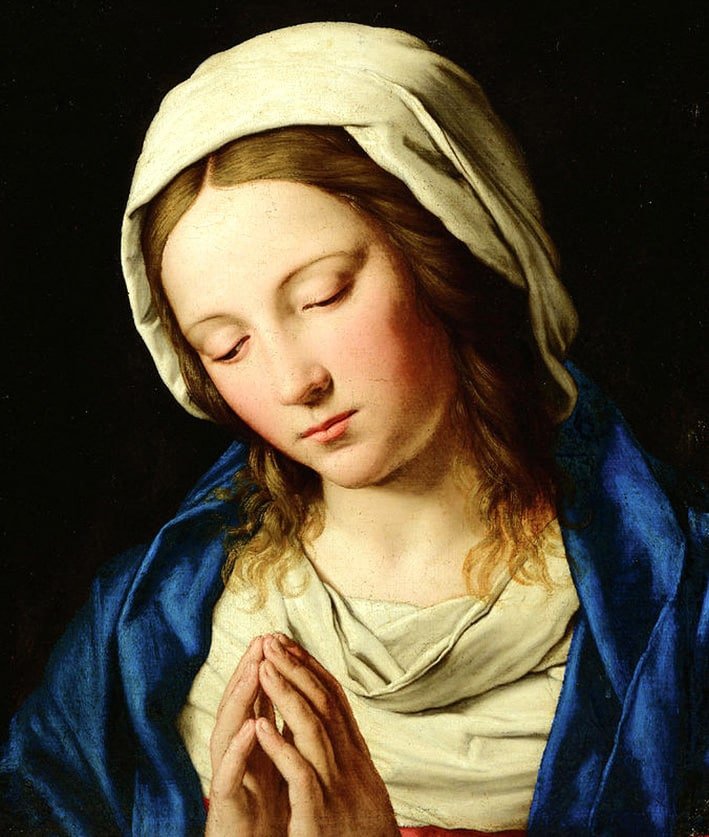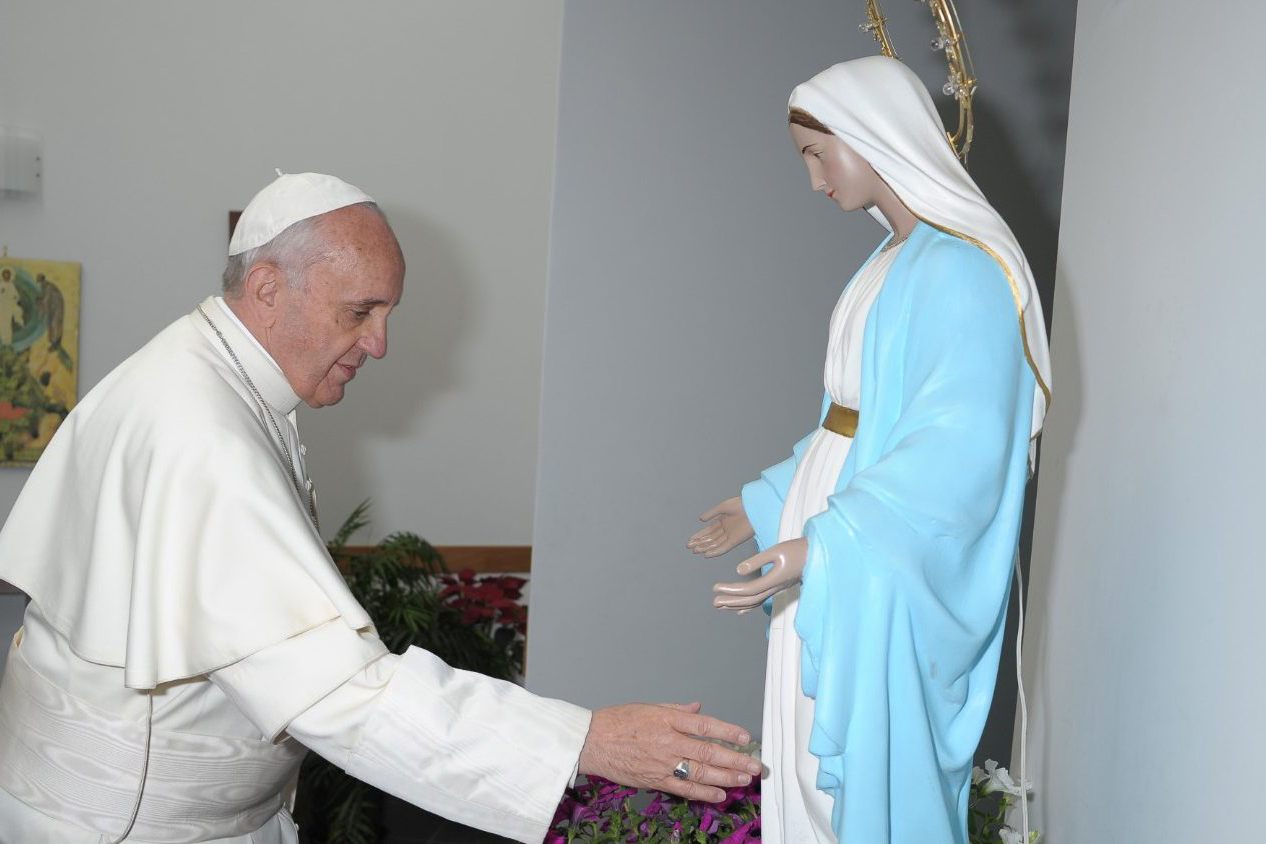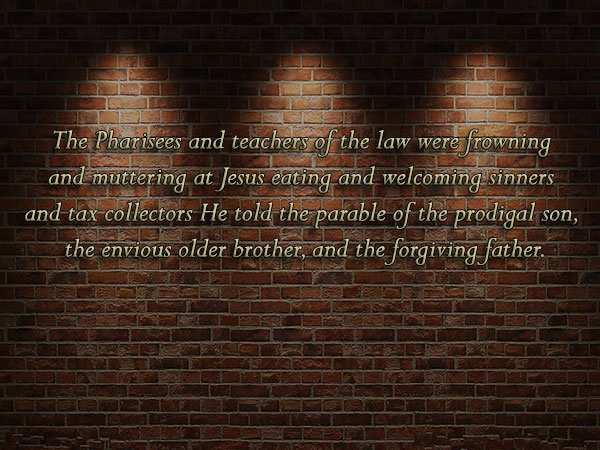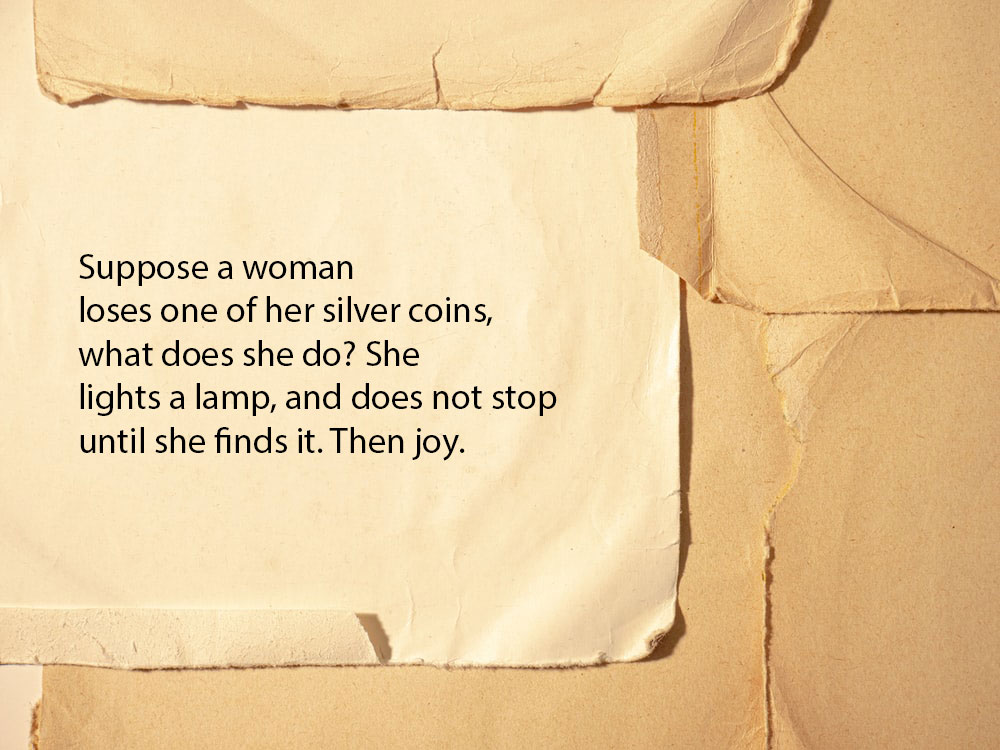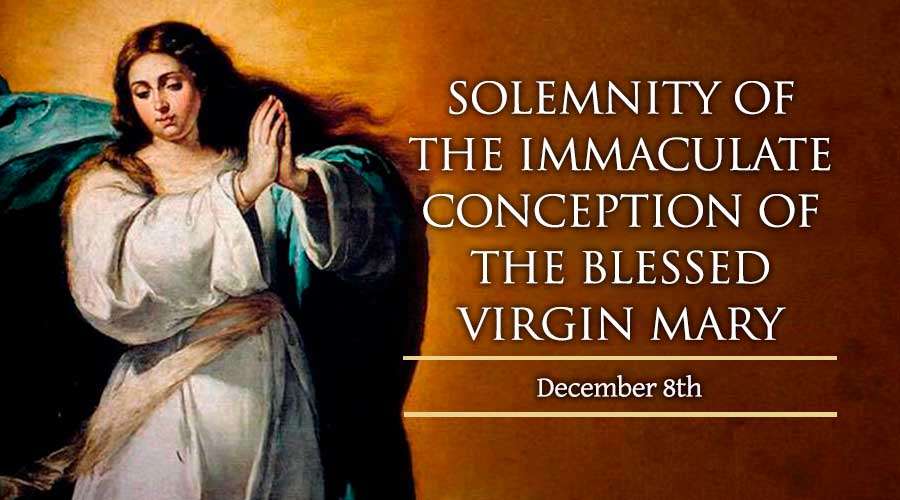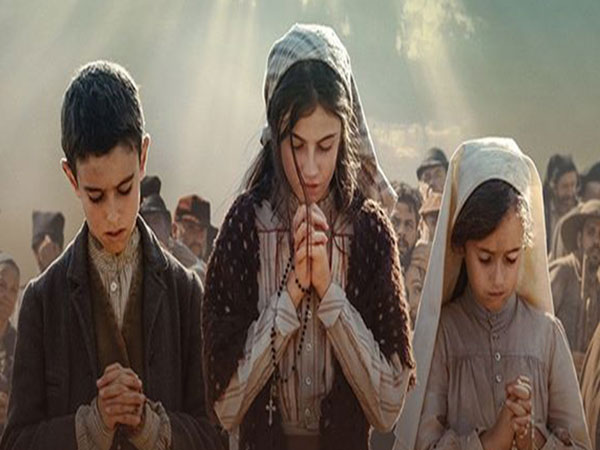THE HALLW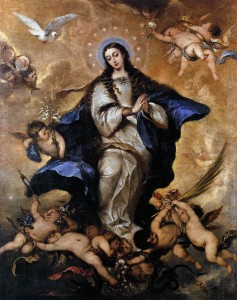 AY BETWEEN Anima and Spiritus Halls used to serve as a midsection of the two function rooms. When PREX conducts their bimonthly seminar, the hallway is used as a venue for praying over the speakers before their talks or lifting up the participants as they meditate on a just-concluded discourse. There was a time when it became a storage area for sewing machines, chairs, tables and other stuff. Until Fr. Bobot Clemen, Holy Spirit Parish Priest, envisioned its transformation to a hallowed place as a tribute to the Blessed Virgin Mary (BVM). The concept was enthusiastically received by (then) PPC Chair Ate Thelma (Ponferrada). She conferred with Ate Ella (Doller) and Kuya Boni (Limos), indefatigable PPC members and church servants like her, and the vision soon bloomed into a blue spectacle. These prime movers happen to share mutual feelers from the Blessed Lady.
AY BETWEEN Anima and Spiritus Halls used to serve as a midsection of the two function rooms. When PREX conducts their bimonthly seminar, the hallway is used as a venue for praying over the speakers before their talks or lifting up the participants as they meditate on a just-concluded discourse. There was a time when it became a storage area for sewing machines, chairs, tables and other stuff. Until Fr. Bobot Clemen, Holy Spirit Parish Priest, envisioned its transformation to a hallowed place as a tribute to the Blessed Virgin Mary (BVM). The concept was enthusiastically received by (then) PPC Chair Ate Thelma (Ponferrada). She conferred with Ate Ella (Doller) and Kuya Boni (Limos), indefatigable PPC members and church servants like her, and the vision soon bloomed into a blue spectacle. These prime movers happen to share mutual feelers from the Blessed Lady.
 AY BETWEEN Anima and Spiritus Halls used to serve as a midsection of the two function rooms. When PREX conducts their bimonthly seminar, the hallway is used as a venue for praying over the speakers before their talks or lifting up the participants as they meditate on a just-concluded discourse. There was a time when it became a storage area for sewing machines, chairs, tables and other stuff. Until Fr. Bobot Clemen, Holy Spirit Parish Priest, envisioned its transformation to a hallowed place as a tribute to the Blessed Virgin Mary (BVM). The concept was enthusiastically received by (then) PPC Chair Ate Thelma (Ponferrada). She conferred with Ate Ella (Doller) and Kuya Boni (Limos), indefatigable PPC members and church servants like her, and the vision soon bloomed into a blue spectacle. These prime movers happen to share mutual feelers from the Blessed Lady.
AY BETWEEN Anima and Spiritus Halls used to serve as a midsection of the two function rooms. When PREX conducts their bimonthly seminar, the hallway is used as a venue for praying over the speakers before their talks or lifting up the participants as they meditate on a just-concluded discourse. There was a time when it became a storage area for sewing machines, chairs, tables and other stuff. Until Fr. Bobot Clemen, Holy Spirit Parish Priest, envisioned its transformation to a hallowed place as a tribute to the Blessed Virgin Mary (BVM). The concept was enthusiastically received by (then) PPC Chair Ate Thelma (Ponferrada). She conferred with Ate Ella (Doller) and Kuya Boni (Limos), indefatigable PPC members and church servants like her, and the vision soon bloomed into a blue spectacle. These prime movers happen to share mutual feelers from the Blessed Lady.December 8 is the Feast of the Solemnity of Mary’s Immaculate Conception. A day momentous enough to bless her sanctuary and unveil its marker. To acknowledge their assistance, devotion and expertise, Ate Ella and Kuya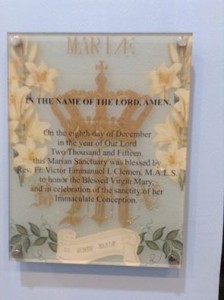 Boni were requested to cut the ceremonial ribbon that opened the gates of the sanctuary to her devotees and the general public.
Boni were requested to cut the ceremonial ribbon that opened the gates of the sanctuary to her devotees and the general public.
 Boni were requested to cut the ceremonial ribbon that opened the gates of the sanctuary to her devotees and the general public.
Boni were requested to cut the ceremonial ribbon that opened the gates of the sanctuary to her devotees and the general public.After the 6 am Mass, all the parishioners, after the floral offering, trekked to the sanctuary while singing “Hail Mary.” After a brief prayer by Fr. Bobot, Ate Thelma called on Ate Ella and Kuya Boni to cut the ceremonial blue ribbon. The ample crowd that attended the inaugural was met by ceiling pin lights that illumined the posters considerably. Then Fr. Bobot unveiled the marker with a brief prayer.
A light breakfast at the prayer garden fronting the sanctuary awaited the joyful crowd; it was made possible through the joint generosity of Fr. Bobot and the Daughters of Mary Immaculate. The yard became abuzz with blessed gladness, praise and thanksgiving.
The sanctuary’s right wall contains eight life-size posters of Eucharistic Miracles linked with our Lady. (On the left wall right past the entrance are popular images of Our Lady in the Philippines: Our Lady Mediatrix of all Grace, Lipa;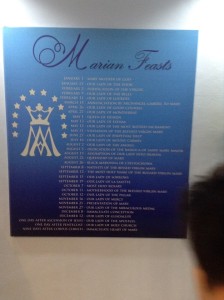 Our Lady of Piat; Our Lady of Manaoag; Our Lady of Penafrancia; Our Lady of Antipolo; Our Lady of Caysasay; Our Lady of EDSA; and Our Lady of La Naval. Further ahead is Our Lady of the Barangay flanked by the Magnificat and Ave, Maris Stella. Next to the threesome is a blue poster where all the Marian feasts are listed.) The marker is placed on a pillar across from the Memorare. The posters will virtually “transport” the visitor to the places where the miracles of our Lady and the Eucharist took place. Permission to download and print the posters was granted by Ms. Antonia Salzano, Curator of the Pontificia Accademia Cultorum Martyrum (the PPC took an effort in translating the English texts in Tagalog for bilingual benefit; there are also brochures in English). Ms. Salzano is based in the Vatican and the mother of Carlo Acutis, the young servant of God who did all the Eucharistic Miracles exhibition. (A separate feature on him will be written.)
Our Lady of Piat; Our Lady of Manaoag; Our Lady of Penafrancia; Our Lady of Antipolo; Our Lady of Caysasay; Our Lady of EDSA; and Our Lady of La Naval. Further ahead is Our Lady of the Barangay flanked by the Magnificat and Ave, Maris Stella. Next to the threesome is a blue poster where all the Marian feasts are listed.) The marker is placed on a pillar across from the Memorare. The posters will virtually “transport” the visitor to the places where the miracles of our Lady and the Eucharist took place. Permission to download and print the posters was granted by Ms. Antonia Salzano, Curator of the Pontificia Accademia Cultorum Martyrum (the PPC took an effort in translating the English texts in Tagalog for bilingual benefit; there are also brochures in English). Ms. Salzano is based in the Vatican and the mother of Carlo Acutis, the young servant of God who did all the Eucharistic Miracles exhibition. (A separate feature on him will be written.)
 Our Lady of Piat; Our Lady of Manaoag; Our Lady of Penafrancia; Our Lady of Antipolo; Our Lady of Caysasay; Our Lady of EDSA; and Our Lady of La Naval. Further ahead is Our Lady of the Barangay flanked by the Magnificat and Ave, Maris Stella. Next to the threesome is a blue poster where all the Marian feasts are listed.) The marker is placed on a pillar across from the Memorare. The posters will virtually “transport” the visitor to the places where the miracles of our Lady and the Eucharist took place. Permission to download and print the posters was granted by Ms. Antonia Salzano, Curator of the Pontificia Accademia Cultorum Martyrum (the PPC took an effort in translating the English texts in Tagalog for bilingual benefit; there are also brochures in English). Ms. Salzano is based in the Vatican and the mother of Carlo Acutis, the young servant of God who did all the Eucharistic Miracles exhibition. (A separate feature on him will be written.)
Our Lady of Piat; Our Lady of Manaoag; Our Lady of Penafrancia; Our Lady of Antipolo; Our Lady of Caysasay; Our Lady of EDSA; and Our Lady of La Naval. Further ahead is Our Lady of the Barangay flanked by the Magnificat and Ave, Maris Stella. Next to the threesome is a blue poster where all the Marian feasts are listed.) The marker is placed on a pillar across from the Memorare. The posters will virtually “transport” the visitor to the places where the miracles of our Lady and the Eucharist took place. Permission to download and print the posters was granted by Ms. Antonia Salzano, Curator of the Pontificia Accademia Cultorum Martyrum (the PPC took an effort in translating the English texts in Tagalog for bilingual benefit; there are also brochures in English). Ms. Salzano is based in the Vatican and the mother of Carlo Acutis, the young servant of God who did all the Eucharistic Miracles exhibition. (A separate feature on him will be written.)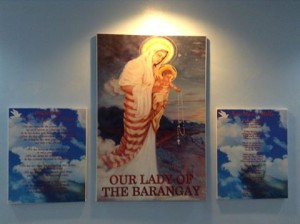
Upon entering, the visitor will immediately see on the right wall of the sanctuary the posters depicting:
The Apparition in Guadalupe.
Our Lady of Guadalupe, also known as the Virgin of Guadalupe, is a title of the Virgin Mary associated with a celebrated pictorial image housed in the Basilica of Our Lady of Guadalupe, in Mexico City. The Basilica is the most visited Catholic pilgrimage site in the world, and the world’s third most-visited sacred site. The apparition reflects the indisputable history of the Eucharist and the Incarnation of the Son of God, “Flesh of Christ, flesh of Mary,” says St. Augustine.
Official Catholic accounts state that on the morning of December 9, 1531, a native peasant named Juan Diego saw a vision of a maiden at a place called the Hill of Tepeyac. Speaking to him in his native language, the maiden identified herself as the Virgin Mary, “mother of the very true deity,” and asked for a church to be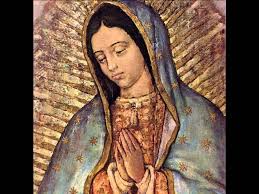 built on that site in her honor.
built on that site in her honor.
 built on that site in her honor.
built on that site in her honor.From her words, Juan Diego sought out the archbishop of Mexico City to tell him what had happened. The archbishop instructed him to return to the Hill and ask the lady for a miraculous sign to prove her identity. The first sign she gave was the healing of Juan’s uncle. The Virgin also told Juan to gather flowers from the top of the Hill, which was normally barren in December. Juan followed her instructions and he found Castilian roses, not native to Mexico, blooming there. Juan arranged the flowers in his tilma, or cloak, and when Juan Diego opened his cloak before the archbishop on December 12, the flowers fell to the floor, and on the fabric was the image of the Virgin of Guadalupe.
Historically the devotion to Our Lady of Guadalupe did not lack clerical opponents within Mexico, especially in the early years, and in more recent times some Catholic scholars, even a former abbot of the basilica, openly doubted the historical existence of Juan Diego. Nonetheless, Juan Diego was canonized in 2002, under the name Saint Juan Diego Cuauhtlatoatzin.
The Miracle in Calanda, Zaragoza, Spain.
On March 29, 1640, through the intercession of Our Lady of Pilar in Zaragoza, in the village of Calanda, a young farmer regained his right leg, amputated more than two years earlier and buried in the hospital cemetery. After long and careful consideration of all the archives and the places concerned, the journalist Vittorio Messori, in a recent book, presented the story of the shocking miracle.
Miguel Juan Pellicer was twenty at the onset of 1637 when he moved from the village of Calanda, where he had been born in a poor and large family, to work as a laborer for his maternal uncle. In late July, while leading a two-wheeled farm wagon loaded with grain, riding one of the mules , he probably fell asleep, fell to the ground and the two-wheeled wagon ran over his right leg, below the knee, fracturing the tibia.
He received first aid and was accompanied by his uncle to a hospital in Valencia, where he stayed for only five days and decided to seek treatment in Zaragoza, a journey which took 50 days. First, however, he stopped at the famous shrine of Our Lady of Pilar where he went to confession, received communion and recommended himself to the Blessed Virgin.
The head of the hospital and his colleagues found that the gangrene was too severe and that the only way to save his life was to amputate the leg. The leg was buried in a special area in the cemetery of the hospital while Pellicer remained hospitalized for several months and was released in the spring of 1638 with a wooden leg and crutches. He lived for the next two years as a beggar at the shrine of Our Lady of Pilar. Every evening, he anointed the stump of the leg with a little oil from the eighty lamps that burned continuously in the Lady Chapel, convinced that he could obtain the help of the Virgin this way. In March of 1640 the curate from his home town persuaded him to return to his home, assuring him the affection of his f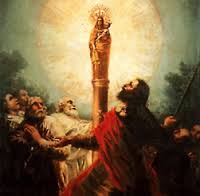 amily, so he decided to return to Calanda.
amily, so he decided to return to Calanda.
 amily, so he decided to return to Calanda.
amily, so he decided to return to Calanda.In the evening of March 29, after a meager dinner, he went to sleep on a makeshift bed. At about 11 pm, his mother entered his room and “smelled a scent never smelled before” and saw that Miguel did not have one foot, but two, cruzadosc, crossed, as she testified later. The son woke up and said that he was dreaming of being in the sanctuary of Pilar and was anointing his leg with blessed oil; he was convinced that the healing had been through the intercession of Our Lady of Pilar.
The news spread immediately, people rushed to Calanda and authorities examined and investigated the phenomenon. The process resulted in the recognition of the authenticity of the miracle. From the reports emerged that the new leg appeared to be the same leg that had been amputated two and half years earlier, recognized by some pre-existing scars and scratches. When the area where it had been buried was dug, it was empty.
The Miraculous Madonna of Montserrat.
In 1657, during one of the conferences at the Monastery of Our Lady of Montserrat, a woman and ger young daughter showed up and the daughter began to beg Abbot Don Millan de Mirando to celebrate three Masses in memory of her deceased father, wholeheartedly convinced that with these Masses, the soul of her father would be freed from the pains of purgatory. The good abbot, moved to tears by the girl, began to celebrate the first Mass of suffering the next day and the girl, who was present with her mother, confirmed seeing her father kneeling, surrounded by frightening flames, at the step of the main altar.
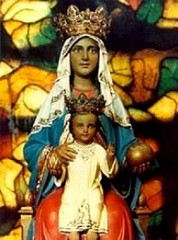
The abbott and one of those present doubtfully asked the girl to put a tissue close to the flames that surrounded her father in order to verify her story. Following the request, the girl put the tissue into the fire, which only she could see, and the tissue began to burn with a lively flame. During the second Mass, the girl confirmed having seen her father dressed in a vibrantly-colored suit standing hext to the deacon. At the third Mass, the father appeared to his daughter dressed in a snow-white suit. As soon as the Mass ended the girl exclaimed, “There is my father going away and rising into the sky!” Then the girl thanked the community of monks on her father’s behalf as he had asked her to do..
The Eucharistic miracle of Montserrat brings us to reflect on the reality of purgatory and reminds us that every Mass has an infinite value because it makes the unique sacrifice of Christ suffering on Calvary present in our minds.
St. Catherine Labouré.
She was born in the Burgundy region of France to Pierre Labouré, a farmer, and Louise Madeleine Gontard, the ninth of 11 living children. Catherine’s mother died on October 9, 1815, when Catherine was just nine years old. It is said that after her mother’s funeral, Catherine picked up a statue of the Blessed Virgin Mary and kissed it saying, “Now you will be my mother.” Her father’s sister offered to care for his two youngest children, Catherine and Tonine. After he agreed, the sisters moved to their aunt’s house in a village nine kilometers from their home. She was extremely devout, of a somewhat romantic nature, given to visions and intuitive insights. As a young woman, she became a member of the nursing order founded by St. Vincent De Paul. She chose the Daughters of Charity after a dream about him.
Visionary.
Catherine claimed that on July 19, 1830, the eve of the feast of St. Vincent, she woke up after hearing the voice of a child calling her to the chapel, where she heard the Virgin Mary say to her, “God wishes to charge you with a mission. You will be contradicted, but do not fear; you will have the grace to do what is necessary. Tell your spiritual director all that passes within you. Times are evil in France and in the world.”
On November 27, 1830, Catherine reported that the Blessed Mother returned to her during evening meditations. She displayed herself inside an oval frame, standing upon a globe, rays of light coming out of her hands towards the globe. Around the margin of the fra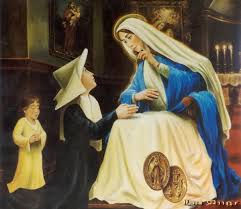 me appeared the words “O Mary, conceived without sin, pray for us who have recourse to thee.” As Catherine watched, the frame seemed to rotate, showing a circle of twelve stars, a large letter M surmounted by a cross, and the stylized Sacred Heart of Jesus and Immaculate Heart of Mary underneath. Asked why some of the rays of light did not reach the globe, Mary reportedly replied, “Those are the graces for which people forget to ask.” Catherine then heard Mary ask her to take these images to her father confessor, telling him that they should be put on medallions. “All who wear them will receive great graces.” Catherine did so, and after two years’ worth of investigation and observation of Catherine’s normal daily behavior, the priest took the information to his archbishop without revealing Catherine’s identity. The request was approved and the design of the medallions was commissioned through a French goldsmith. They proved to be exceedingly popular. The dogma of the Immaculate Conception had not yet been officially promulgated, but the medal with its “conceived without sin” slogan was influential in popular approval of the idea. Pope John Paul II used a slight variation of the reverse image as his coat of arms, a plain cross with an M in the lower right quadrant of the shield.
me appeared the words “O Mary, conceived without sin, pray for us who have recourse to thee.” As Catherine watched, the frame seemed to rotate, showing a circle of twelve stars, a large letter M surmounted by a cross, and the stylized Sacred Heart of Jesus and Immaculate Heart of Mary underneath. Asked why some of the rays of light did not reach the globe, Mary reportedly replied, “Those are the graces for which people forget to ask.” Catherine then heard Mary ask her to take these images to her father confessor, telling him that they should be put on medallions. “All who wear them will receive great graces.” Catherine did so, and after two years’ worth of investigation and observation of Catherine’s normal daily behavior, the priest took the information to his archbishop without revealing Catherine’s identity. The request was approved and the design of the medallions was commissioned through a French goldsmith. They proved to be exceedingly popular. The dogma of the Immaculate Conception had not yet been officially promulgated, but the medal with its “conceived without sin” slogan was influential in popular approval of the idea. Pope John Paul II used a slight variation of the reverse image as his coat of arms, a plain cross with an M in the lower right quadrant of the shield.
 me appeared the words “O Mary, conceived without sin, pray for us who have recourse to thee.” As Catherine watched, the frame seemed to rotate, showing a circle of twelve stars, a large letter M surmounted by a cross, and the stylized Sacred Heart of Jesus and Immaculate Heart of Mary underneath. Asked why some of the rays of light did not reach the globe, Mary reportedly replied, “Those are the graces for which people forget to ask.” Catherine then heard Mary ask her to take these images to her father confessor, telling him that they should be put on medallions. “All who wear them will receive great graces.” Catherine did so, and after two years’ worth of investigation and observation of Catherine’s normal daily behavior, the priest took the information to his archbishop without revealing Catherine’s identity. The request was approved and the design of the medallions was commissioned through a French goldsmith. They proved to be exceedingly popular. The dogma of the Immaculate Conception had not yet been officially promulgated, but the medal with its “conceived without sin” slogan was influential in popular approval of the idea. Pope John Paul II used a slight variation of the reverse image as his coat of arms, a plain cross with an M in the lower right quadrant of the shield.
me appeared the words “O Mary, conceived without sin, pray for us who have recourse to thee.” As Catherine watched, the frame seemed to rotate, showing a circle of twelve stars, a large letter M surmounted by a cross, and the stylized Sacred Heart of Jesus and Immaculate Heart of Mary underneath. Asked why some of the rays of light did not reach the globe, Mary reportedly replied, “Those are the graces for which people forget to ask.” Catherine then heard Mary ask her to take these images to her father confessor, telling him that they should be put on medallions. “All who wear them will receive great graces.” Catherine did so, and after two years’ worth of investigation and observation of Catherine’s normal daily behavior, the priest took the information to his archbishop without revealing Catherine’s identity. The request was approved and the design of the medallions was commissioned through a French goldsmith. They proved to be exceedingly popular. The dogma of the Immaculate Conception had not yet been officially promulgated, but the medal with its “conceived without sin” slogan was influential in popular approval of the idea. Pope John Paul II used a slight variation of the reverse image as his coat of arms, a plain cross with an M in the lower right quadrant of the shield.Death and Legacy.
Sister Catherine spent the next forty years caring for the aged and infirm. For this she is called the patroness of seniors. She died on December 31, 1876 at the age of seventy. Her body is encased in glass beneath the side altar at 140 Rue du Bac, Paris.
Her cause for sainthood was declared upon discovering her body was incorrupt, which currently lies in the Chapel of Our Lady of the Miraculous Medal. She was beatified on May 28, 1933 by Pope Pius XI, and canonized on July 27, 1947 by Pope Pius XII. Her official feast day is November 25, though it is also celebrated on November 28 or December 31.
Our Lady of Lourdes.
This Roman Catholic title of the Blessed Virgin Mary is venerated in honor of the Marian apparitions said to have occurred on numerous occasions in 1858 in the vicinity of Lourdes, France. The first of those is the apparition of 11 February 1858, when Bernadette Subirous, a 14-year-old peasant girl, admitted to her mot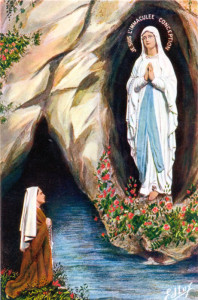 her that a “lady” spoke to her in the cave of Massabielle (a mile from the town) while she was gathering firewood with her sister and a friend. Similar apparitions of the alleged “lady” were reported on seventeen occasions that year, until the climax revelation of Our Lady of the Immaculate Conception took place. Bernadette Subirous was later canonized as a saint and Roman Catholics and some Protestants believe her apparitions have been validated by the overwhelming popularity and testament of healings claimed to have taken place at the Lourdes water spring.
her that a “lady” spoke to her in the cave of Massabielle (a mile from the town) while she was gathering firewood with her sister and a friend. Similar apparitions of the alleged “lady” were reported on seventeen occasions that year, until the climax revelation of Our Lady of the Immaculate Conception took place. Bernadette Subirous was later canonized as a saint and Roman Catholics and some Protestants believe her apparitions have been validated by the overwhelming popularity and testament of healings claimed to have taken place at the Lourdes water spring.
 her that a “lady” spoke to her in the cave of Massabielle (a mile from the town) while she was gathering firewood with her sister and a friend. Similar apparitions of the alleged “lady” were reported on seventeen occasions that year, until the climax revelation of Our Lady of the Immaculate Conception took place. Bernadette Subirous was later canonized as a saint and Roman Catholics and some Protestants believe her apparitions have been validated by the overwhelming popularity and testament of healings claimed to have taken place at the Lourdes water spring.
her that a “lady” spoke to her in the cave of Massabielle (a mile from the town) while she was gathering firewood with her sister and a friend. Similar apparitions of the alleged “lady” were reported on seventeen occasions that year, until the climax revelation of Our Lady of the Immaculate Conception took place. Bernadette Subirous was later canonized as a saint and Roman Catholics and some Protestants believe her apparitions have been validated by the overwhelming popularity and testament of healings claimed to have taken place at the Lourdes water spring.In 1862, Pope Pius IX authorized Bishop Bertrand-Sévère Laurence to permit the veneration of the BVM in Lourdes. On 3 July 1876, the same pontiff officially granted a canonical coronation to the image that used to be in the courtyard of what is now part of the Rosary Basilica. This title, Our Lady of Lourdes, has been widely copied and reproduced, often displayed in shrines and homes, most notably in garden landscapes.
The Angel of Peace.
The Angel of Peace appeared three times to the shepherds and gave holy communion saying, “Eat and drink the body and blood of Jesus Christ…”
Our Lady of Fátima, formally known as Our Lady of the Holy Rosary of Fatima is a Roman Catholic title of the BVM based on apparitions reported to be experienced by three shepherd children at Fátima, Lucia Santos and her cousins Jacinta and Francisco Marto. They were young and without much education when they reported the apparition of Our Lady of Fátima in 1917. The local administrator initially jailed the children and threatened that he would boil them one by one in a pot of oil. The children were consoled by the other inmates in the jail, and then led the inmates in praying the Rosary.
The vision is also referred to as Our Lady of the Rosary because the children said the vision called herself the “Lady of the Rosary” and she appeared holding a rosary.
The events at Fátima gained fame due to elements of secrecy, prophesy and eschatology, particularly with regard to Second World War and possibly more global wars in the future. Chief among these is the alleged urgent need for the consecration of Russia to the Immaculate Heart of Mary.
With millions of followers and Roman Catholic believers, the reported visions at Fatima gathered widespread respect. After a canonical inquiry, the visions of Fátima were officially declared “worthy of belief” in October 1930 by the Bishop of Leiria-Fátima. Five popes voiced their acceptance of the supernatural origin of the Fátima events. John Paul II credited Our Lady of Fátima with saving his life following an assassination attempt on her feast day in 1981. He donated the bullet that wounded him to the Roman Catholic sanctuary at Fatima, Portugal and it was placed in the crown of the Virgin’s statue.
Initial Angeluc Apparitions.
In the spring and summer of 1916, the shepherd-children were herding sheep at the near their home village of Fátima, Portugal. They claimed to have experienced the visitation of an angel on three separate occasions. The angel taught them prayers to pray, to make sacrifices and to spend time in adoration of the Lord.
On May 13, 1917, Lúcia described seeing a lady “brighter than the sun, shedding rays of light clearer and stronger than a crystal goblet filled with the most sparkling water and pierced by the burning rays of the sun”. While they had never spoken to anyone about the angel, Jacinta divulged her sightings to her family despite Lucia’s admonition to keep this experience private. Her disbelieving mother told neighbors as a joke, and within a day the whole village knew. Further appearances were reported on June 13 and July 13. In these, the lady asked the children to do penance and acts of reparation and make personal sacrifices to save sinners. According to Lúcia’s account, the lad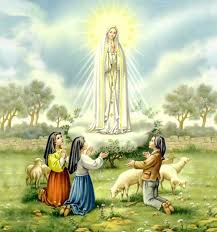 y also confided to them three secrets.
y also confided to them three secrets.
 y also confided to them three secrets.
y also confided to them three secrets.The children subsequently wore tight cords around their waists, performed self-flagellation, abstained from drinking water on hot days and performed other works of penance.
Thousands of people flocked to Fátima and Aljustrel in the following months, drawn by reports of visions and miracles. The provincial administrator, believing that the events were politically disruptive, intercepted and jailed the children before they could reach the Cova da Iria. He interrogated and threatened the children to get them to divulge the contents of the secrets. Lúcia told him everything short of the secrets, and offered to ask the Lady for permission to tell the Administrator the secrets. That month, instead of the usual apparition in the Cova da Iria on the 13th, the children reported that they saw the Virgin Mary on 15 August, the Feast of the Assumption, at nearby Valinhos.
Miracle of the Sun.
As early as July 1917 it was claimed that the Virgin Mary had promised a miracle for the last of her apparitions on October 13, so that all would believe. What happened then became known as the “Miracle of the Sun”. A huge crowd, variously estimated between 30,000 and 100,000, including newspaper reporters and photographers, gathered at the Cova da Iria. The incessant rain had ceased and there was a thin layer of cloud. Lúcia, seeing light rising from the lady’s hands and the sun appearing as a silver disk, called out “look at the sun!” She later had no memory of saying this.
Witnesses later spoke of the sun appearing to change colors and rotate like a wheel. Witnesses gave widely varying descriptions of the “sun’s dance.” A poet and a schoolteacher with her students and other witnesses in the town of Alburita reported that the solar phenomenon was visible up to forty kilometers away. However, the phenomenon was not visible in other parts of the globe, where the Sun was noticeable at the time of the supposed miracle.
Varied reports on the phenomenon followed. The sun “trembled, made sudden incredible movements outside all cosmic laws,” ‘danced’ according to the typical expression of the people,” “seemed to be loosened from the sky and approaching the earth, strongly radiating heat,” was “seen to whirl and turn in the circle of broken clouds,” and so on. Critics point to the fact that the crowd was not encouraged to look at the sun until the alleged miracle was already underway- the children did not tell the crowd to expect a sun miracle. Additionally, people in towns up to forty kilometers away, who had no knowledge of the alleged supernatural events at Fatima, also reported seeing the phenomenon. Another theory is a mass hallucination stimulated by the religious fervor of the crowd. On January 25, 1938, bright lights, an aurora borealis, appeared all over the northern hemisphere. It was the widest occurrence of the aurora since 1709 and people in Paris and elsewhere believed a great fire was burning and fire departments were called. Lúcia, the sole survivor of the three children at the time, indicated that it was the sign foretold and so apprised her superior and the bishop in letters the following day. Just over a month later, Hitler seized Austria and eight months later invaded Czechoslovakia.
Three Secrets of Fátima.
The first secret was a vision of hell, which Lúcia described in her Third Memoir. The second secret included Mary’s instructions on how to save souls from hell and convert the world to the Christian faith, also revealed by Lúcia in that Memoir. A vision of the death of the Pope and other religious figures was transcribed by the Bishop of Leiria as the third secret which, according to Pope Benedict XVI, “has a permanent and ongoing significance” and that “its significance could even be extended to include the suffering the Church is going through today as a result of the recent reports of abuse involving the clergy.”
Fátima Prayers and Reparations.
Many Roman Catholics recite prayers based on Our Lady of Fátima. Lúcia later said that, in 1916, she and her cousins had several visions of an angel calling himself the “Angel of Portugal” and the “Angel of Peace” who taught them to pray “My God, I believe, adore, hope in and I love you. I ask pardon for those who do not believe, adore, hope in and love you.” She also said that the Lady emphasized Acts if Reparation and prayers to console Jesus for the sins of the world. Lúcia said that Mary’s words were “When you make some sacrifice, say ‘O Jesus, it is for your love, for the conversion of sinners and in reparation for sins committed against the Immaculate Heart of Mary.'” At the first apparition, Lúcia wrote, the children were so moved by the radiance they perceived that they involuntarily said “Most Holy Trinity, I adore you! My God, my God, I love you in the Most Blessed Sacrament.” Lúcia also said that she heard Mary ask for these words to be added to the Rosary after the Gloria Patri prayer: “O my Jesus, pardon us, save us from the fires of hell. Lead all souls to heaven, especially those in most need.”
In the tradition of Marian visitations, the “conversion of sinners” is not necessarily religious conversion to the Roman Catholic Church, for that would be the “conversion of heretics or apostates who are ‘outside the church and alien to the Christian Faith’ according to Pope Leo XIII in his encyclical on the Unity of the Church, Satis Cognitum”. Conversion of sinners refers to general repentance and attempt to amend one’s life according to the teachings of Jesus for those Catholics who do profess the faith truly, but are fallen into sins. Lúcia wrote that she and her cousins defined “sinners” not as non-Catholics but as those who had fallen away from the church or, more specifically, willfully indulged in sinful activity, particularly “sins of the flesh” and “acts of injustice and a lack of charity towards the poor, widows and orphans, the ignorant and the helpless” which she said were even worse than sins of impurity.
The Marian Sanctuary is open daily from 7 am until 8 pm and encourages visits, vigils and even sharing of sentiments obtained from manifestations of the Holy Mother of God.
Source: www.wikipedia.com
_________________________
Abraham de la Torre


